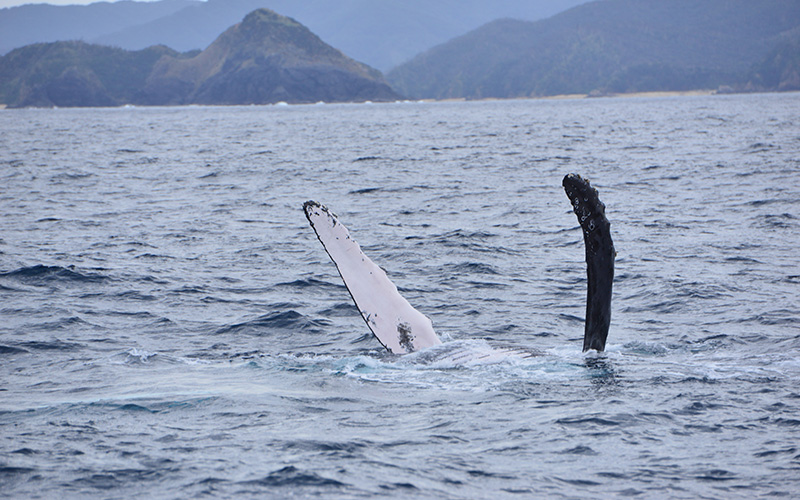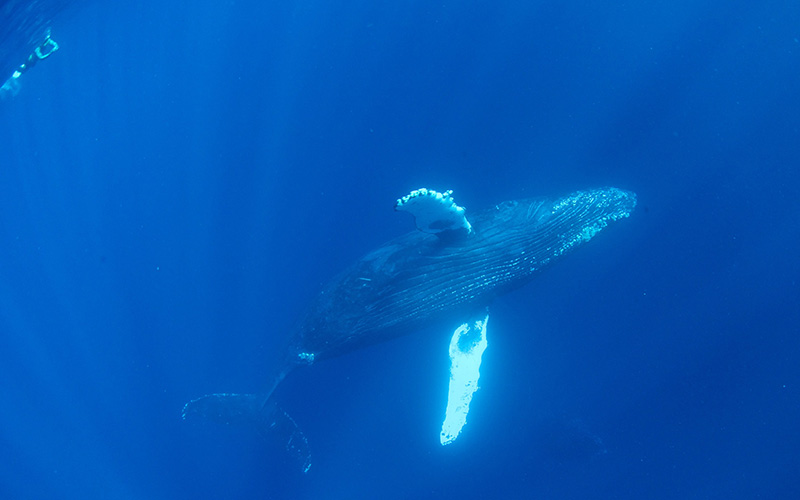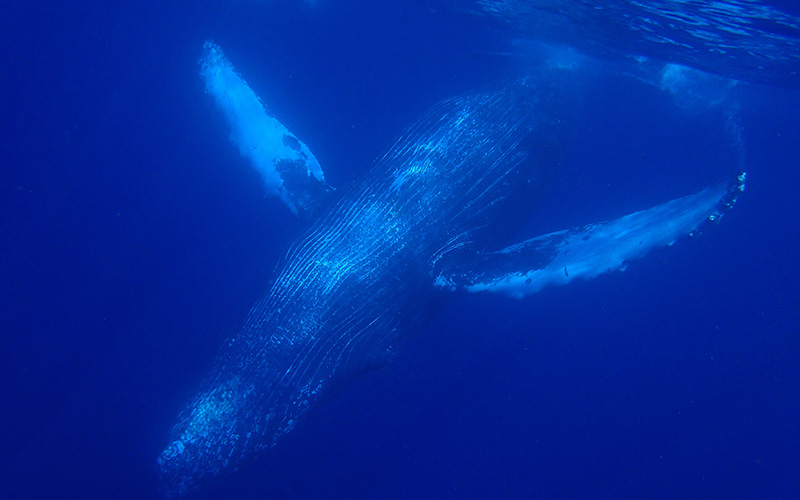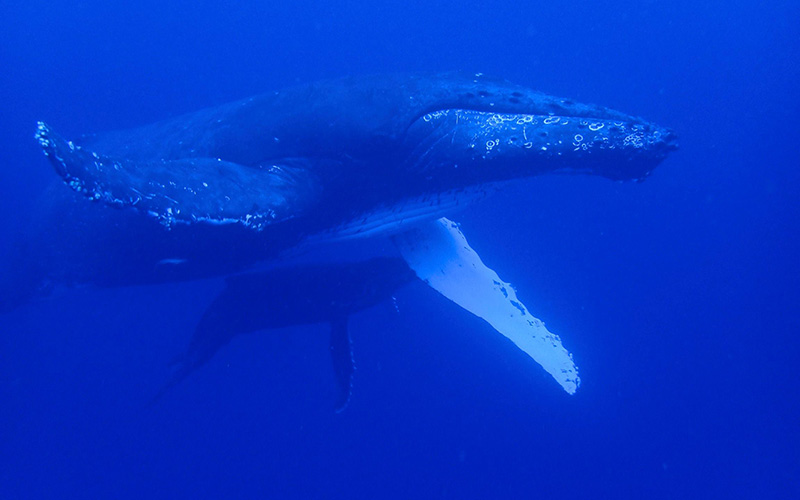Whale watching
Every December-April, whales come from the Siberian sea to Amami sea to raise their children. Want to see that dynamic appearance?
| period | Mid January to end of March |
|---|---|
| Venue | Yui port、Koniya port |
| Course & price | 3 hours course 7,000 yen 6 hours course 12,000 yen (excluding tax) *Please note that there is no refund even if we do not see the whales. |
| Minimum Number of participants | From 4 people *If the number of participants is less than the required number, it is possible to hold the amount that is insufficient with the consent of all the participants. *Those with hangovers, colds, or who are pregnant are not allowed to board the boat. |
| Reservation | For shared rides, you can join from one person. |
| What to bring | Anti-sickness medicine, drink, lunch, etc. (6-hour course), warm clothes (even if it gets wet), camera, etc. *We recommend thick clothing as the temperature on the ship will be lower than the sensible temperature on land. You may be splashed by waves and spray. If you are prone to seasickness, please bring a medicine for motion sickness. |
| cancellation charge | Cancellation fee: 100% on the appointed day, 70% the day before, 50% 2 to 5 days prior to the appointed day, 30% 5 to 14 days prior to the appointed day |
There is also a large bump on the head.
The white and black patterns on the tail fin are different for each whale (like a human fingerprint), which is a clue to identify the individual. Humpback whales that come to Amami Oshima feed herring and krill on the northern Aleutian Islands and the Bering Sea during the summer months of June to October, and in winter they come all the way to the warm Amami Oshima Island to mate, give birth and raise their young.
Whale song
Male humpback whales sing songs in breeding waters and are called whale songs. The whale song is composed of several phrases and is sung by using high and low voices. Humpback whales in the same waters sing the same melody throughout the season. There seems to be a popular song of the year. Lol
Why do they sing? A territorial battle between males? Is it a signal to their company? Is it a love song for females? I would like to ask the whale what the message in the song means.
Whale action
Different whale actions that can be seen in whale watching.
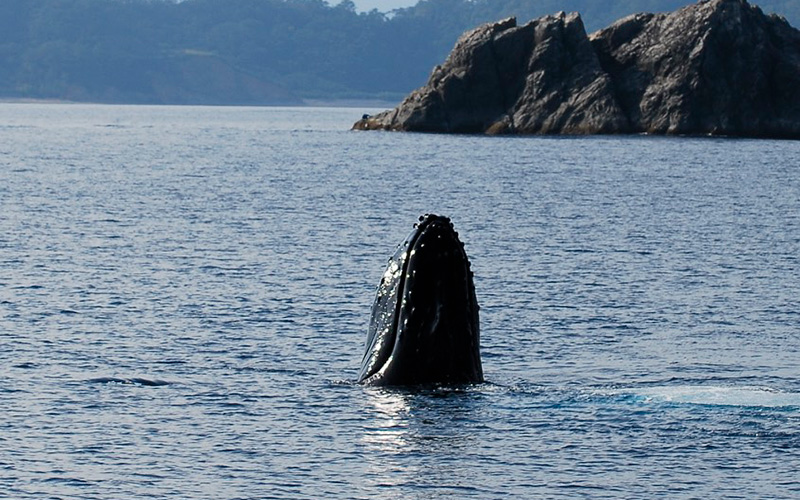
Spy hop
Rarity:Action of the whale lifting its body vertically and only emerging from the surface of the water. It turns its body 30 to 180 degrees and then sinks slowly below the surface. It's believed to be checking their position. Lucky to see while whale watching! You'll probably see eye to eye with a whale.

Bleach
Rarity:It lifts its body from the water's surface into the air, thrusts its pectoral fins out to the sides, and spins in the air before falling from its back into the sea. It is considered to be an action when they want to remove parasites from their bodies.It also gives a signal to its friends by making a loud noise.
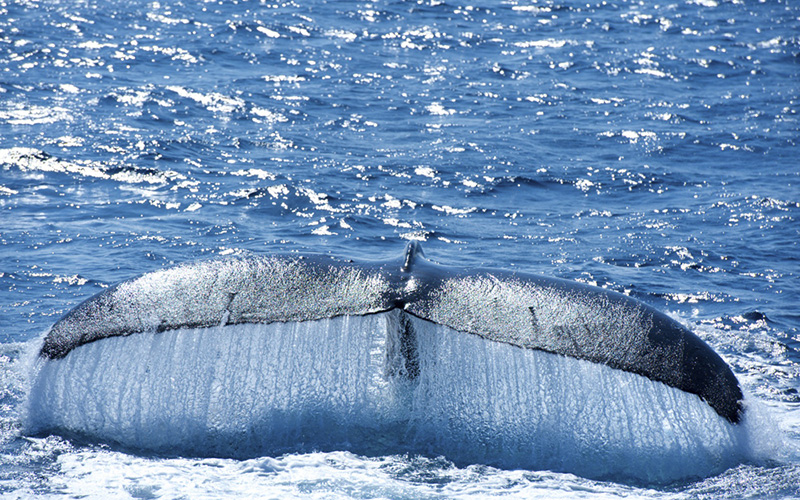
Fluke up & down
Rarity:The whale has finished catching its breath and is about to dive. This dive pose is called Fluke and is often seen in whale watching. At that time, when the pattern on the back of the tail fin is shown, it is called "fluke up", and when it is not shown, it is called "fluke down". Since the pattern of the underside of the tail fin is different for each whale, we can identify them by it.
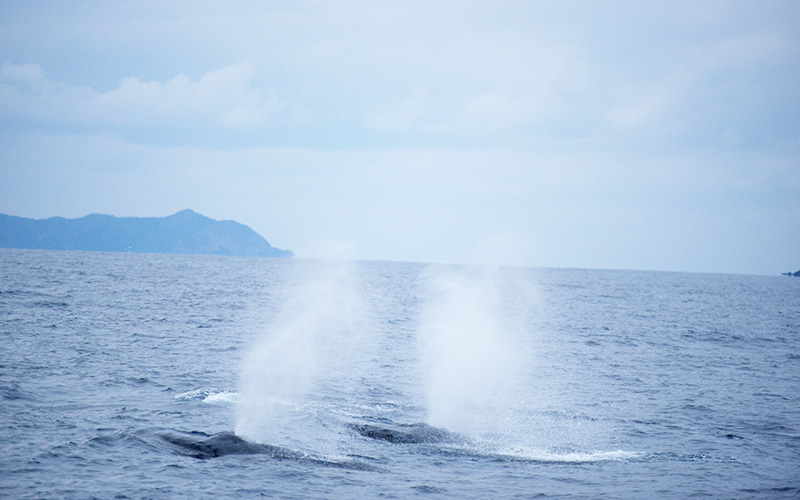
blow
Rarity:Squirt A whale breathes with a splash of water overhead. The whale blows 4 to 5 meters high from its overhead blowhole and blows 2 to 3 times per surface. After diving, re-emergence is about 5 to 20 minutes. To find lots of whales, look for lots of blows!
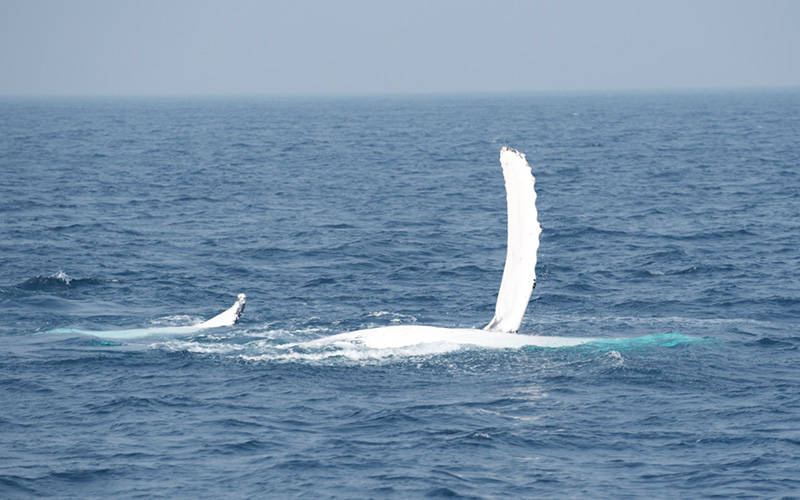
Peck slap
Rarity:The whale turns sideways and strikes the surface of the water with its long pectoral fins, which can be 4-5 m long. Sometimes they turn their ventral side up and strike both pectoral fins.It is also believed that they make a loud noise to signal their friends. They are often seen when they are in a good mood, so you can watch them leisurely.

Head slap
Rarity:The action is to lift about one-third of the body to the surface of the water, hit the body as it is to the surface of the sea, and splash water around. In rare cases, the whole body may come out, so it is a powerful action superior to bleach. It is said to be a show of one's own power or a threatening action against other whales.
Whale group composition
It is a composition of whales seen in whale watching.
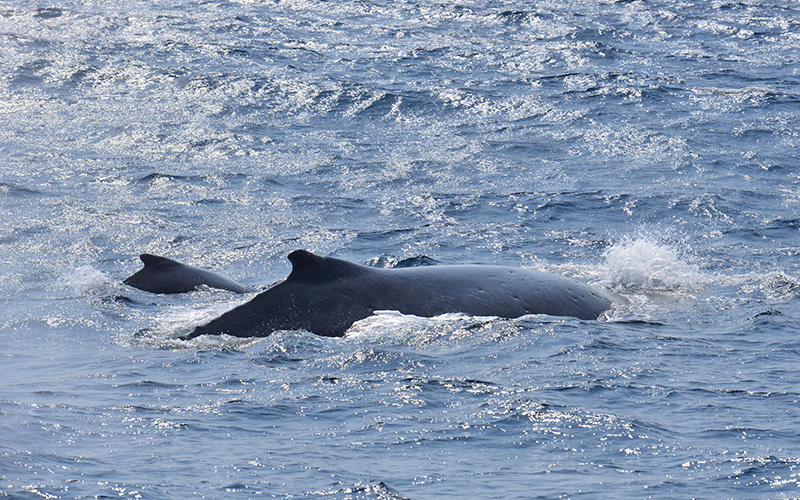
Parent and child (mother and child)
The mother whale does not move much and raises a baby whale. It is said that the baby will be weaned in about one year. In Amami Oshima Island, the same mother and child were once seen for 15 days.
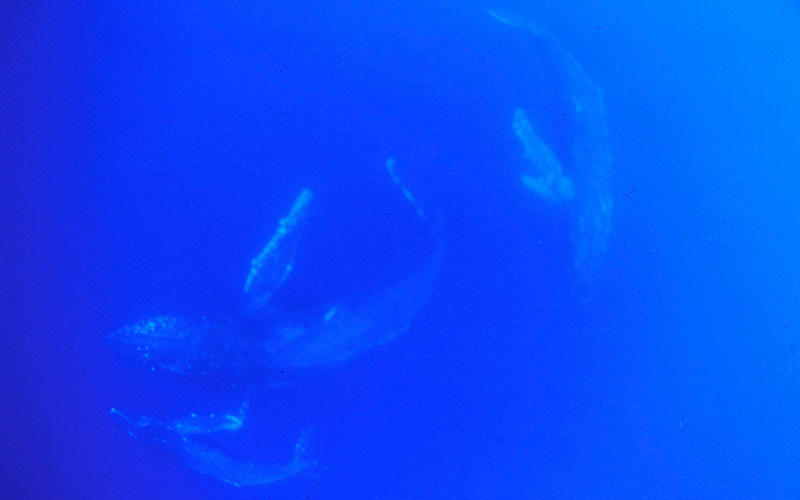
Parent and child and escort
The male whale swims together with the mother and calf as he watches over them.It seems that they are also asking for mating opportunities.

pair
A pair of male and female. The male may appear to be beside the female while inviting with various aquations. We have also seen a male whale singing and dancing next to a female whale.

singer
A male whale singing. They often sing while staying in the same spot, but sometimes they sing while swimming. On Amami Oshima, there was also a singer who sang at the same place for 7 days!

Alone
Alone wolf? male? Female? The young whales are very serviceable, and sometimes they play near breach and boats. Occasionally, you can see them in the water.
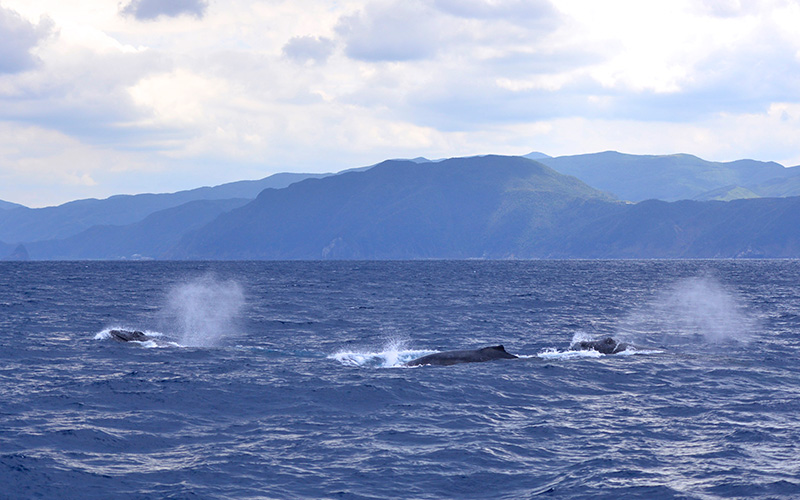
Mating pod
Competition for female whales. It's a head on fight between the males! When the number is small, it is about 3, but the number is increasing and it may be 10 or more. As they heat up, they compete with each other, exhaling, flying again, slapping their fins, and the loud roar that blows out is also powerful!
Whale Swim
Whale Swim
Would you like to swim with whales?
A small group of up to 8 swimmers. You can apply from one person.
(In the case of those who only want to watch, 6 to 9 people can board aboard separately from the swimmer)
| period | Mid January to end of March |
|---|---|
| Venue | Yui port、Koniya port |
| Fee | 6 hours course 22,000 yen (excluding tax) |
| Minimum Number of participants | You can apply from one person. (In the case of those who only want to watch, 6 to 9 people can board aboard separately from the swimmer) |
| Conditions of participation | Only experienced diving license (C-card) holders will be accepted for dolphin and skin diving. If you are unsure about your skills, please contact us. Those with hangovers, colds, or who are pregnant are not allowed to board the boat. Please make a reservation by email or phone. |
| Reservation | You can book from 1 person. |
| What to bring | Anti-sickness medicine, drink, lunch, etc. (6-hour course), warm clothes (even if it gets wet), camera, Wetsuit, change of clothes, towel, etc. *Swimming uses snorkels and fins to move the water surface. We do not recommend dry suits, which have more restricted movement than wet suits. It is recommended to wear heavy clothing as the temperature on board will be lower than the sensible temperature on land. You may be splashed by waves and spray. If you are prone to seasickness, please bring a medicine for motion sickness. |
| cancellation charge | Cancellation fee after booking: 100% on the appointed day, 70% the day before, 50% 2 to 5 days prior to the appointed day, 30% 5 to 14 days prior to the appointed day |
Whale swim voluntary rules
- 1, The captain will decide if the swim is possible according to the sea conditions and the condition of the target whale.
- 2.Swim should not interfere with the course and natural behavior of the target whale.
- 3, The number of swims to the same group need to be up to 8 people.
- 4.The number of swims should be one per group, and alternate for multiple ships.
- 5.The swim will be conducted by snorkeling in the sea and scuba diving is not allowed.
- 6.Swim participation qualification must be a diving C card license holder or above.
- 7.If target whales are the same, give priority to watching boats.
- 8.Others, such as vessel maneuvering rules, are in accordance with the Association Watching Rules.
Amami Whale and Dolphin Association HPhttps://amamiwhale.jimdo.com
Whale swim boat charter
It is a plan for those who want to enjoy privately with friends and family.
| period/th>Mid January to end of March | |
|---|---|
| Venue | Yui port、Koniya port |
| Fee | 6 hours per day for up to 8 people 114,400 yen (excluding tax) 1 additional person 14,300 yen (excluding tax) 1 hour extension 14,300 yen (excluding tax) |
| Reservation | You can book from 1 person. |
| cancellation charge | It will cost 100% after November 1st. *If there is a sudden cancellation, you will not be able to make reservations for flights or accommodations, and it will be difficult to recruit again. Thank you for your understanding. |

